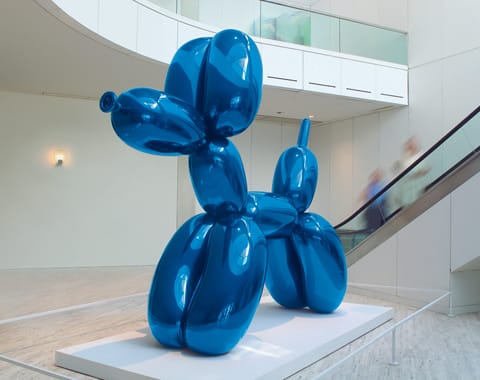The Artist Who Sold a Rabbit for $91.1 Million
Jeff Koons, an American artist born in York, Pennsylvania, in 1955, has become one of the most influential and controversial figures in contemporary art. Renowned for his larger-than-life sculptures and bold, colourful works, Koons has redefined the boundaries between high art and popular culture.

Koons' journey into the art world began in his early years. Growing up in a family that appreciated art, Jeff Koons was encouraged to pursue his artistic talents from a young age. He later attended the Maryland Institute College of Art in Baltimore and the School of the Art Institute of Chicago in the 1970s, where he honed his craft and developed a unique vision that would soon set him apart from his contemporaries.
In 1977, Koons moved to New York City, a vibrant hub for emerging artists. It was here that he first made his mark, working at the Museum of Modern Art and engaging with the city's avant-garde art scene. His early works, such as the "Inflatables" series, hinted at his future obsession with consumer culture and mass-produced objects, themes that would become central to his work.
Koons' work is perhaps best epitomised by his "Balloon Dog" series, which has become a symbol of his entire oeuvre. These sculptures, made of stainless steel with a mirror-finish and transparent colour coating, resemble the balloon animals crafted by street performers. However, Koons elevates this mundane, playful object into a monumental work of art, blurring the line between kitsch and high art.
The "Balloon Dog" series consists of five individual sculptures, each in a different colour—blue, magenta, orange, red, and yellow. These works exemplify Koons' fascination with scale, surface, and the interplay between the familiar and the extraordinary. The reflective surface of the sculptures not only captivates the viewer but also implicates them in the work, as their reflection becomes part of the piece. This interaction is a key element of Koons' art, inviting the audience to engage with the work on a personal level.

Koons' work has never been without its detractors. Critics often accuse him of pandering to commercialism and argue that his art lacks depth. His use of a large team of assistants to create his pieces—much like a Renaissance master with his workshop—has also sparked debates about authorship in art.
Despite the criticism, Koons has consistently defended his approach, stating that his work is about celebrating the everyday and breaking down the barriers between high and low culture. His pieces are meticulously crafted, often requiring years of production, and are infused with a sense of joy and wonder that resonates with many.
One of his most controversial works, "Made in Heaven," features explicit images of Koons and his then-wife, Ilona Staller, in various sexual poses. The series was created in the late 1980s and early 1990s and was met with shock and outrage. Yet, it also underscored Koons' commitment to exploring the boundaries of art and the role of the artist as both creator and subject.
The Record-Breaking Sale of a Living Artist's Work
Jeff Koons has not only made a significant impact on the art world but also on the art market. His works have fetched record-breaking prices at auction, with his "Rabbit" sculpture selling for $91.1 million in 2019 at Christie's, making it the most expensive work by a living artist ever sold at auction at that time.
This market success is a testament to Koons' ability to tap into the current trends and create works that resonate with collectors and the public alike. His art is a reflection of our consumer-driven society, where the boundaries between art, commerce, and culture are increasingly blurred.
Koons' influence extends beyond his own work. He has inspired a generation of artists who see no shame in embracing popular culture and commercial aesthetics. His art challenges us to reconsider our definitions of taste, value, and meaning in art.
In many ways, Jeff Koons is a product of his time—an artist who emerged in an era of mass media, celebrity culture, and consumerism. Yet, his work transcends these influences, offering a commentary on the human condition that is both playful and profound.
Whether you admire or disdain his work, there's no denying that Jeff Koons has left an indelible mark on the art world. His ability to merge the everyday with the extraordinary, to provoke thought and debate, and to captivate audiences worldwide ensures that his legacy will endure for generations to come.
Koons reminds us that art does not have to be obscure or elitist to be significant. By embracing the symbols and aesthetics of popular culture, he has created a body of work that speaks to the modern experience in a language that is both accessible and complex. In doing so, Jeff Koons has not only redefined the possibilities of art but also invited us all to see the world through a different lens.





